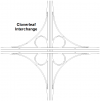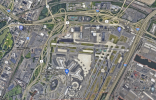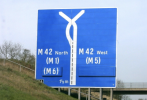ABB125
Established Member
Following on from the London Ringways thread, the topic of cloverleaf junctions came up.
For those of you who haven't (yet!) reached the point where road junctions are a really exciting topic ( ), here's a diagram of one for you to look at:
), here's a diagram of one for you to look at:

There are only two examples in the UK, in Redditch and in Livingston (the next junction north from this used to also be a cloverleaf, but for some reason was changed to what it's like now). Neither are on what could be termed as fast, high capacity or strategic roads, which may explain their limitations. In continental Europe and North America however, they are very common: in Germany, for example, it's very difficult to find a 4-way Autobahn junction which isn't either a cloverleaf, used to be a cloverleaf but has since been upgraded, of is a cloverleaf-derivative - and these examples are often only different because of limiting geography, such as this one. There are also amusing examples, such as here, where the road was quite clearly meant to continue north through the cloverleaf, but was never built, resulting in a bodge.
The main issues with cloverleaves are that traffic coming off one loop has to cross over traffic leaving via the next loop, with horrendous consequences for capacity as a result, the tight loops, and the large land-take. They are, however, easy and cheap to build (only one bridge): I think this is the main reason why they're so prevalent in countries like Germany with very old motorway networks - there are comparatively few engineering challenges. And the land take isn't too much of an issue: if you were a 1930s German landowner, would you say nein to der Fuehrer? Probably not! In the USA, land is plentiful, hence the large number of cloverleaves.
The weaving problems caused by cloverleaves can be substantially reduced by adding parallel carriageways for turning traffic - virtually all German cloverleaves have been upgraded in this way. You can even do this - a fully grade-separated cloverleaf - but obviously that's only been done because ripping out the existing junction and replacing it with something more suitable would be far too disruptive.
Having rambled on for far too long by now, I've forgotten the point I was going to make! Hopefully someone will find this interesting, and subsequent replies may cause my memory to start working again!
Hopefully someone will find this interesting, and subsequent replies may cause my memory to start working again!
(This thread isn't just limited to cloverleaf junctions, by the way, fee free to discuss other designs!)
For those of you who haven't (yet!) reached the point where road junctions are a really exciting topic (

There are only two examples in the UK, in Redditch and in Livingston (the next junction north from this used to also be a cloverleaf, but for some reason was changed to what it's like now). Neither are on what could be termed as fast, high capacity or strategic roads, which may explain their limitations. In continental Europe and North America however, they are very common: in Germany, for example, it's very difficult to find a 4-way Autobahn junction which isn't either a cloverleaf, used to be a cloverleaf but has since been upgraded, of is a cloverleaf-derivative - and these examples are often only different because of limiting geography, such as this one. There are also amusing examples, such as here, where the road was quite clearly meant to continue north through the cloverleaf, but was never built, resulting in a bodge.
The main issues with cloverleaves are that traffic coming off one loop has to cross over traffic leaving via the next loop, with horrendous consequences for capacity as a result, the tight loops, and the large land-take. They are, however, easy and cheap to build (only one bridge): I think this is the main reason why they're so prevalent in countries like Germany with very old motorway networks - there are comparatively few engineering challenges. And the land take isn't too much of an issue: if you were a 1930s German landowner, would you say nein to der Fuehrer? Probably not! In the USA, land is plentiful, hence the large number of cloverleaves.
The weaving problems caused by cloverleaves can be substantially reduced by adding parallel carriageways for turning traffic - virtually all German cloverleaves have been upgraded in this way. You can even do this - a fully grade-separated cloverleaf - but obviously that's only been done because ripping out the existing junction and replacing it with something more suitable would be far too disruptive.
Having rambled on for far too long by now, I've forgotten the point I was going to make!
(This thread isn't just limited to cloverleaf junctions, by the way, fee free to discuss other designs!)


